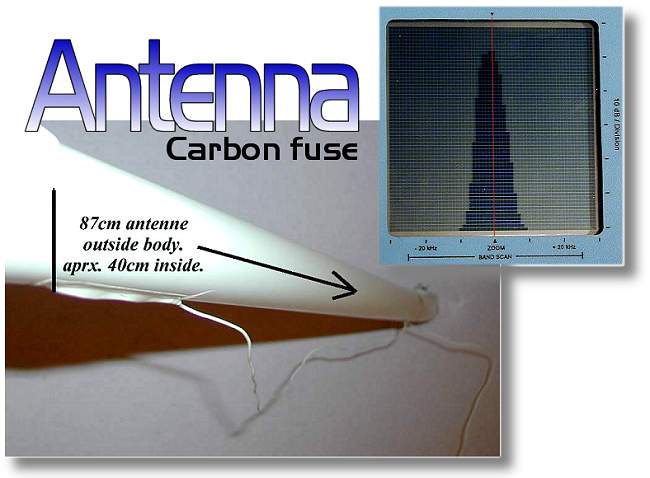Range Check - Carbon Fuses
All new fuses from Samba is made of full carbon / kevlar.
carbon / kevlar fuses are much stronger and lighter than conventional glass
fuses. If anyone wants glass fuses it is no problem just specify it in your
order to your local dealer.
Some precautions needs to be
made when using carbon fuses because carbon leads electrical currents and
also bounces our transmitter signal in a bad way. The most important is that
we do not want our antennas to be parallel / near the on the outside of the
fuse. Make some solution to get the antenna away from the fuse and you have
found your solution.
Here is some solutions used by the worlds best pilots.
Range Check:
How range check is done is different to each brand of Radio used.
Normally the range without any disturbance should be at least 50-100m with the
transmitter antenna 20cm long and the airplane in 1m height over ground. If
this is not achieved then DO NOT FLY YOUR MODEL.
Receiver type:
Always use a good receiver mainly of Dual
Conversion / Dobbel Super -type.
Always use crystal from the same company as the Rx
Good and proven receiver is (many others is also good):
- Graupner SMC receivers (example SMC14)
- Multiplex IPD DS receivers
- Shulze 835
- JR 770S (SPCM 72mHz) tested 04/2005 on solution 4 with very good results
2,4GHz:
There is ways to install a 2,4GHz antenna in a carbon fuse. But we strongly
recommend buying a specially designed fuse for this. The fuse has the same
strength as standard fuse but have glass/kevlar/aramid in the front section.
See Perfect 2,4GHz site
Antenna length:
Antenna length is important for our receivers.
Common knowledge have been that it needs to be exactly as delivered by
manufacturer. This is in many ways wrong. Best antenna length at 35mHz is
around 9m long. Since this is impossible in a model airplane the receiver is
electronically changed so that shorter antennas can be used. Normally the
antenna of a typical receiver on 35mHz is 80-90cm long and a bit shorter for
40mHz.
Lengthening the antenna by 30-100cm is no problem and only increases reception
quality.
There are a few length that one should avoid because of the wavelength we are
using. 100-110cm and 200-220cm antenna length is not good length. Other
length is no problem.
Since most of our antenna length is inside the carbon housing of the fuse we
always lengthen the antenna that is outside the fuse.
Not quite comparative to our carbon fuses but an interesting article about
antenna length
HERE
Your model:
There are many ways of getting good reception and it is always different
solutions in different models.
Try the different solutions or find your own solution. This page does not
describe the only way to do it.
Tip: We do not recommend ALU-arms on your servos. Metal against metal and
long metal pushrod can make problems in some setups.
Solution 1 - Antenna inside fuse and out at tail:
Very simple and reliable solution used in competions for
many years. A small hole in front of the rudder is all it takes. Can be
tested just out of the hingeline but a hole is recommended so the rudder
does not get stuck. Lengthen your antenna so that 30-40cm comes outside the
bottom of the tail.
Almost the same as solution 3 but not as complicated. The point is to get
the antenna away from the "tv-antenna" mid point beetween fuse and wing. So
it is inside the fuse and exits at the end of the fuse. Almost like your car
antenna. It works best when it is seated on the bumber or on the roof. Not
beside your door and window. The reason that we want the exit on bottom is
that the transmitter is on the ground and we look up on the plane... With a
MPX IPD DS, Graupner SMC14, 19, etc. this solution is tested to give 50-100m
range with antenna collapsed and above 2km with antenna up (tested on
ground). All offcourse deppending on conditions that day.
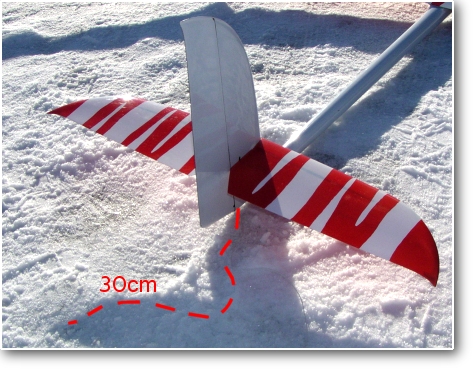
Solution 2:
Take out the antenna just behind the wing and lengthen it so that 80-90cm is
outside of fuse. Tape the first 10-30cm to the fuse so that it is not in the
way while throwing the model. You can tape the antenna further back but have
at least 20-30cm of it hanging straight down.
Do always take the antenna out BEHIND the wing as this as proven to be better
than by the nosecone.
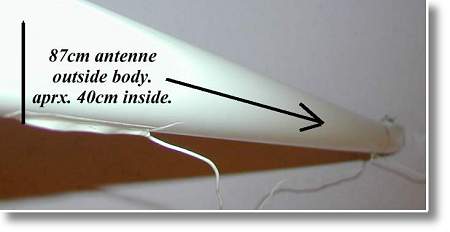
Solution 3 - Inside V-tail:
This solution involves some more soldering and work but it looks nice and
makes the antenna disappear.
Lengthen the antenna and take it all the way inside the fuse. Glue two 20-30cm
long wires inside the hinge line of your V-tail. Solder the two ends to the
end of the antenna coming out of the fuse.
You have now one antenna that works like a Y-antenna and is good in any angle
of the fuse to the ground.
If better reception is needed you can solder a 10-20cm long wire to the solder
point at the back of the fuse and the antenna works like a X-antenna.
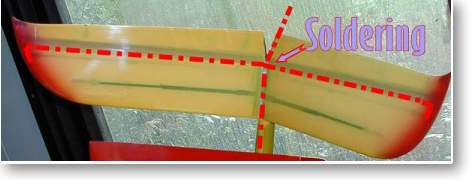
Solution 4 - Inside X-tail:
This solution is almost the same as solution 2 but here we need also 20cm of
0,5-0,8mm iron rod.
The solution also involves some more soldering and work but it looks nice and
makes the antenna look cool also. Lengthen the antenna and take it all the
way inside the fuse and up the hinge line of the rudder. Solder the end of
the antenna to a 0,5-0,8mm iron rod that is drilled out the top of the
rudder going backwards. Make a bend on the iron rod inside the rudder and
glue it inside the rudder.
You have now one antenna that is away from the parallel length of the fuse and
should give you good range. Be sure to make a bend / circle at the end of
the iron rod so that you do not harm you eyes.
Also one can exit at the hingeline and tape the rod to the rudder top. Be
sure that the rod does not come in contact with carbon in joint of
the two rudderparts or inside the rudder. This will cause the antenna to be
grounded.
Best reception in different angles is actually made with a "bend" on the rod
outside. Otherwise it can have some "shadow" angles.

Solution 5 - Antenna outside to top of rudder:
This solution is simple and easy. It is also well proven
by many pilots.
Take out the antenna just behind the wingseat and lengthen (solder) the
antenna so that 80-90cm are outside the fuse. Make a wire or rubber to the
top of the rudder and attach to the end of the antenna. This can also be
done on a V-tail.
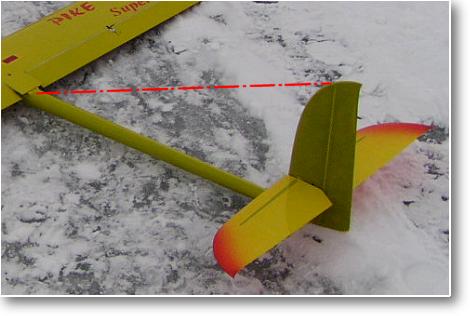
Solution 6 - Glass fuse:
Samba model is proud to say that your wishes is always listened to. If you
want glass fuse to prevent any problems with interference just order it. Any
special wishes is always welcome with our company. We might need some more
time to produce your wish but we are there for you!
For Samba Model 2003 - Solutions by
Jo Grini




